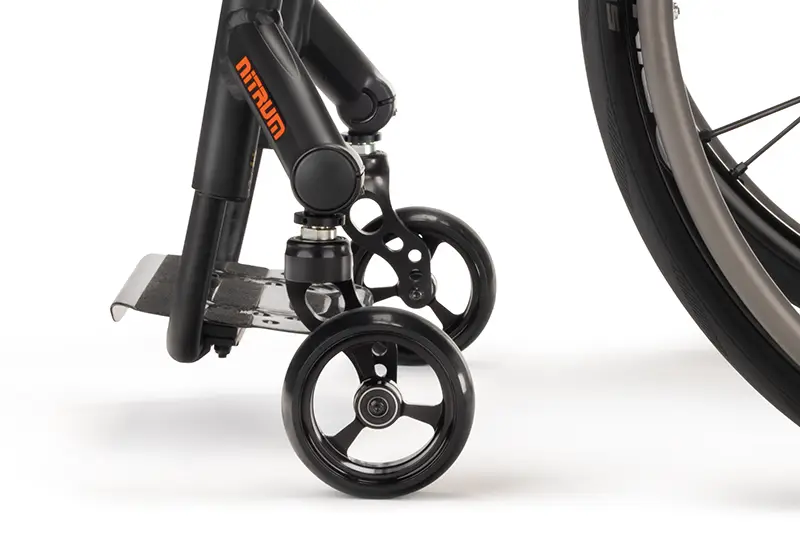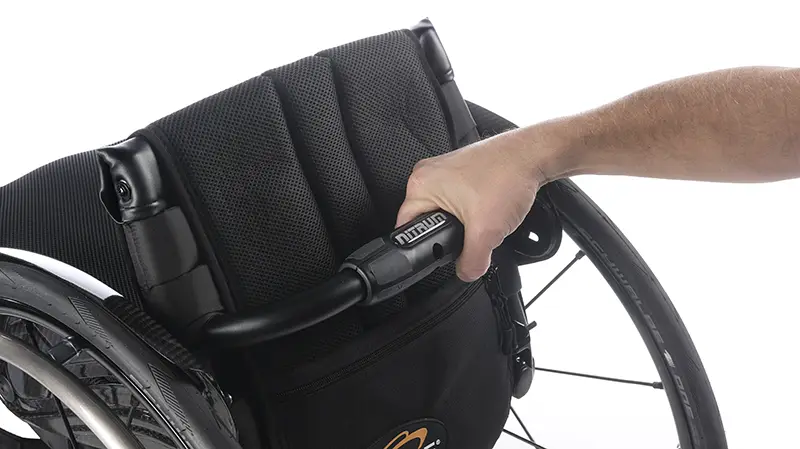An energy efficient manual self-propelled wheelchair is designed to maximize the distance traveled with each wheel push. This isn't simply to create a more pleasant experience. It helps to reduce the risk of long-term repetitive strain injury to the upper limbs, already under increased use in most wheelchair riders.1,2 Wheelchair propulsion is an inherently high energy consuming task.3 Efficient wheelchairs reduce a person's effort in propulsion, leaving energy to do valued daily tasks throughout the day.4,5 An efficient wheelchair isn't only for ease of moving a wheelchair around, it's an integral part of fatigue management. This effect is even more critical for people who have underlying conditions associated with fatigue like multiple sclerosis, chronic fatigue, and long COVID. The longer and more challenging distances someone travels, the greater impact an energy efficient wheelchair has on all daily living activities.
Let's discuss some of the technologies behind active rider wheelchairs and the benefits of these technologies. This article refers to Sunrise Medical's range of products, but it can apply to wheelchairs from any manufacturer.
Rigidity
Flex in the wheelchair's frame dissipates some of the force of pushing, leaving less to propel the wheelchair forward. By increasing frame rigidity, pushing is more efficient. One way to do this is to use a rigid frame so that no energy is lost in the flex of a folding mechanism. At the same time, technology can make a folding frame much more rigid and can enhance a rigid frame to have even less flex.
Materials and manufacturing impact a chair's rigidity, and therefore its ability to translate a wheel push into forward motion. Aerospace-grade 7020 aluminum (used in chairs like the QUICKIE QS5 X and Nitrum) has less flex than more standard 6000 series aluminum. Beyond the material, tubing shape also impacts wheelchair rigidity. Compared to traditional round tubing, oval-shaped tubing increases stiffness by up to 15%. How this shaping is achieved factors into rigidity as well. For example, hollow forging, a method of progressively compressing and heating metal can create a lightweight but very stiff and strong frame. This technique is used in some caster housings (such as on the QUICKIE Nitrum) to maintain ease of maneuvering in an area that faces high impacts daily.
In addition to the frame itself, components impact the stiffness and responsiveness of a self-propelled wheelchair. Reducing the number of bolts and other fasteners not only saves weight, but also reduces the risk of parts rattling loose and introducing flex within the system that can reduce the ease of wheelchair propulsion. Many fully custom chairs like those from RGK reduce fasteners by eliminating unnecessary adjustments. For people who still require adjustment, the goal is to allow adjustment and movement where it's needed and eliminate it where it isn't needed. An example is swaging technology on the QUICKIE QS5 X, which compresses frame tubes to reduce the number of bolts and secondary internal frame tubes required to hold the frame together.
But it's not just the main frame section that contributes to rigidity. Pushing a wheelchair requires stabilizing the trunk against the backrest, so the joint between the backrest and the main wheelchair frame also impacts overall responsiveness. For example, the QUICKIE Nitrum separates the locking pin from the angle adjustment. This allows the angle adjustment to be bolted securely with a tight fit.
Using a solid backrest can also stabilize the trunk for proximal stability, freeing upper limbs for efficient pushing. On some chairs the back design has gone a step further, not only allowing the fitting of a solid back, but creating a low profile back frame option that eliminates the upper back posts for an ergonomic shoulder position while propelling.

Fine tuning
Configurability is the key factor6 for the balance point, access to the rear wheels, and ease of propulsion. Too far forward and the chair becomes rearward tippy, preventing trust in the system for strong pushing strokes. Too far rearward and the wheels become difficult to reach, the traction becomes poor, and the front casters bear more weight which makes them hard to turn. Height and fore/aft position of the rear wheel (center of gravity) is necessary to achieve the right balance point for each individual rider. Using available adjustments for fine tuning can optimize efficiency – ask if these are easy to access where needed.
A well designed and well adjusted caster position is another factor in efficiency. Too far in or back and stability can be compromised. Too far forward or to the side and the chair becomes more cumbersome to turn or it cannot bring the rider close to objects in the environment. Many models have calculated the caster position based on frame size, frame inset, caster wheel, and other factors. Look for ease of adjustment of the caster position to keep it at 90° to the ground even with changes to wheels and years of use. Some models, like the QUICKIE Nitrum and QS5 X, feature several millimeters of vertical adjustment to keep all wheels in solid contact with the ground for energy efficient mobility.

Frame kinematics
Sharing the same root as "cinematics" (the art of making motion pictures), "kinematics" refers to the way something moves. In the case of a wheelchair, this refers to how easily the wheelchair transitions through frame movements. For example, some backrest designs use mechanisms to release easily and lock into place reliably. One example is the twist-to-lock mechanism on the QUICKIE Nitrum. It features a large ergonomic grip, an interior cable mechanism that releases easily, and a pin that drops into the frame for a positive lock when open.

Kinematics are particularly important for folding frames. A well designed folding mechanism feels almost effortless and can make the difference between independence and needing assistance. Two key components of folding frame kinematics are cross brace design and overall frame design:
Cross brace design
The cross brace is the mechanism that allows most folding wheelchairs to collapse. This is often an X-shaped brace. Consideration of the pivot point for hinging makes a folding chair easy to operate by reducing the friction of folding and keeping the sides parallel so that it does not drop into a V shape and chatter along the ground. Balanced folding geometry also enables the chair to remain more stable during the folding process, making it much less likely to fall over. This makes it much easier to manage, and in the case of people with trunk weakness, can prevent overbalancing to right the wheelchair which could lead to strain or injury.
Frame design
Use of details in the structural components of the wheelchair assists in how the wheelchair folds. For example, ovalized tubing not only increases rigidity for propulsion, but also allows thinner walled tubing for a lightweight folding mechanism. In the case of the QUICKIE QS5 X, this allows one more tube to be added without increasing weight for a reliable fold, as well as near rigid-like performance when unfolded.
Weight
While wheelchair configuration has the biggest impact on ease of propulsion, weight is also a factor. One study on newer wheelchair riders proposed a 10% reduction in weight had a 3% increase in velocity.6 In addition to weight impacting efficiency, some technologies that help with rigidity or kinematics can also help lighten the system. For example, 7020 aluminum is both lighter and stiffer than 6000 series aluminum. Fewer components not only reduce the risk of frame flex, but also frame weight. Carbon fiber reduces weight when used for the entire frame or specific components like casters, rear wheels, and footboards. Meanwhile, aluminum frames remain preferred for their high adjustability and compatibility with power add-on devices.
As technology advances in active rider wheelchairs and the innovations from high-end models become accessible in more affordable entry-level options, it will be fascinating to observe future developments. The more therapists and mobility professionals comprehend the connection between technology and wheelchair performance, the more beneficial it will be for our clients.
References
- Veeger, H. E. J., Rozendaal, L. A., & Van der Helm, F. C. T. (2002). Load on the shoulder in low intensity wheelchair propulsion. Clinical biomechanics, 17(3), 211-218.
- Boninger, M. L., Dicianno, B. E., Cooper, R. A., Towers, J. D., Koontz, A. M., & Souza, A. L. (2003). Shoulder magnetic resonance imaging abnormalities, wheelchair propulsion, and gender. Archives of physical medicine and rehabilitation, 84(11), 1615-1620.
- Hashizume, T., Kitagawa, H., Ueda, H., Yoneda, I., & Booka, M. (2017). Efficiency and rolling resistance in manual wheelchair propulsion. In Harnessing the Power of Technology to Improve Lives (pp. 778-781). IOS Press.
- Raggi A. Work-related problems in multiple sclerosis: A literature review on its associates and determinants. Disability and Rehabilitation 2015; 38: 936-945. DOI: 10.3109/09638288.2015.1070295.
- Devitt R, Chau B, and Jutai JW. The Effect of Wheelchair Use on the Quality of Life of Persons with Multiple Sclerosis. Occupational Therapy In Health Care 2004; 17: 63-79. DOI: 10.1080/j003v17n03_05.
- Worobey, L. A., Bernstein, J., Ott, J., Berner, T., Black, J., Cabarle, M., ... & Betz, K. (2023). RESNA position on the application of ultralight manual wheelchairs. Assistive Technology, 1-18.
Faith Brown is an HCPC-registered occupational therapist with over 20 years of international experience in the field of seating and mobility including the British National Health Service, as well as the private and NGO sectors. She has worked with all ages and levels of complexity, including leading an NHS special seating division. She is a research champion for the Royal College of Occupational Therapists and has a history of lifelong professional development. Her post-qualification education includes a postgraduate certificate in Postural Management for People with Complex Disabilities from Oxford Brookes University, an MSc in Health Research Methods from the University of Birmingham (UK) and completion of an engineering module in wheelchair design at the University of San Francisco.